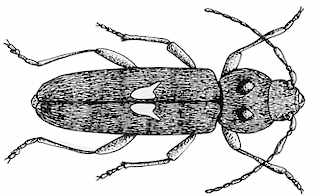House Longhorn Beetle – Hylotrupes bajulus
Next Beetle >>
Habitat

General: Sapwood of most softwoods, particularly roofing timbers.
Solid timber: At present common only in areas of England, SW of London (mainly Surrey) where special Building Regulations exist to protect structural timber and prevent further spread. Small inactive infestations are common in buildings over 100 years old in London. Isolated infestations in other parts of the country usually stem from imported infested packing cases.
Panel products: Very occasionally found in softwood and plywood.
Damage Charactaristics

General: May be overlooked in early stages. With large infestations, larval feeding may be audible on warm days as a scraping noise.
Emergence holes: Few, large, oval, often ragged, 6 – 10 mm diameter.
Tunnels: Oval, 6 – 10 mm diameter. Extensive and join up to cause almost complete disintegration of sapwood but leaving thin, intact, surface skin. Dust-filled tunnels may cause blisters or corrugations on surface of wood which may be observed with oblique lighting from torch.
Bore dust: Cream-coloured, sausage-shaped pellets. Gritty when rubbed between fingers. Small chips and wood fibres may be present.
Likely misidentifications: Forest longhorn beetle, jewel beetle, wharf borer beetle, wood wasp, Tenebrionid beetle, Bostrychid powderpost beetle.
Remedial Treatments:
- Remedial treatment Organic solvent or paste.
- Inspect thoroughly and remove powdered material to determine extent of infestation and any signs of structural weakening.
- Remove and burn all badly-damaged timber.
NOTE: details of suspected outbreaks should be reported to the Building Research Establishment’s Timber Division which maintains records of infestations in the UK.

Appearance
 Larva
Larva
Insect Characteristics and Location:
The male beetle is up to 6mm in length and females up to 25mm. The body is grey black in colour covered in greyish yellow hair.
Eggs are laid in crevices and are about 2mm in length, up to 200 laid at a time.The larva is a fleshy creature and early in its development lives in the surface sapwood which has a high nutritional value enabling fast development, development slows as it tunnels deeper.
White pupa is up to 25mm in length, pupation normally occurring in spring but can be at the end of the year. The larval stage forms the greatest part of the life cycle which is normally from 3-6 years.
Eggs depending on humidity normally hatch within 5-10 days, the pupal stage lasts 11-22 days. This is a serious pest of structural softwood. Often found only in a roof void. The sapwood is the first part to be attacked but later the heartwood may also be attacked.
Next Beetle >>
